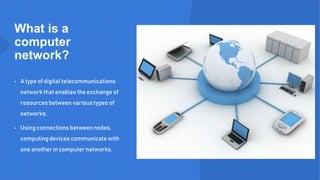CAT Grade 11 (Network Technologies).pptx
- 1. Computer Applications Technology (CAT) Grade 11 Network Technologies Compiled by Mr. S Luvhengo
- 2. Content ŌĆó What is a computer network? ŌĆó Types of network. ŌĆó Advantages of using networks. ŌĆó Disadvantages of using networks. ŌĆó References.
- 3. What is a computer network? ŌĆó A type of digital telecommunications network that enables the exchange of resources between various types of networks. ŌĆó Using connections between nodes, computing devices communicate with one another in computer networks.
- 4. Types of networks. The followingare considered commonly used form of networks available: ŌĆó PAN ŌĆó LAN ŌĆó WAN Let us discuss each in detailin the following slidesŌĆ”
- 5. PAN (Personal Area Network). ŌĆó A PAN is a network of information technology devices that are connected inside the physical space of a single user. ŌĆó The standard distance is ten meters. ŌĆó Among them could be laptops, telephones, printers, or smartphones.
- 6. LAN (Local Area Network). ŌĆó LANs are networks used when computers in an schools require to interact with one another. ŌĆó For a LAN connection, the following are required: Cables (wired and optical), file server terminals, and print servers. ŌĆó LAN does not span over a geographical area greater than a city.
- 7. WAN (Wide Area Network). ŌĆó WANs are used when computers from many locations or continents must connect. ŌĆó WANs span over a large geographical area. ŌĆó A common example of a WAN is the Internet. ŌĆó These networks are used by industry, government, and educational institutions to send data to workers, students, customers, and buyers as well.
- 8. Advantages of using networks. LAN ŌĆó Through computers linked together, we can send data and messages without difficulty. ŌĆó The fact that all data is saved on the file server, data backup is simple. WAN ŌĆó Spans a wider geographic region. ŌĆó Enables individuals or scattered workstations to share resources and programs.
- 9. Disadvantages of using networks. LAN ŌĆó Spans over small geographical area. ŌĆó Calls for ongoing LAN management due to problems with software configuration WAN ŌĆó It is not cheap to setup. ŌĆó Provides fewer safety precautions than various types of networks. ŌĆó Loss of autonomy.
- 10. The End.
- 11. References: Akhter, J. (2021). Network classification. Available from ║▌║▌▀ŻShare at /JyotiAkhter/network-classification- 248352280 (Accessed 16 August 18, 2023). Brown, C. (2018). Network Types and Topologies. Available from ║▌║▌▀ŻShare at /ChristopherBrown22/network-types-and-topologies-102551297 (Accessed 16 August 18, 2023). Dasariya, M. (2018). Types of Computer Network. Available from ║▌║▌▀ŻShare at /MohitDasariya/types-of- computer-network-108484141 (Accessed 16 August 18, 2023). Praba, M. (2023). LAN MAN WAN. Available from ║▌║▌▀ŻShare at /MeisterPraba2/lan-man-wanpptx (Accessed 16 August 18, 2023). Tatheer, F. (2017). Types of computer networks. Available from ║▌║▌▀ŻShare at /TatheerFatima1/types-of- computer-networks-72993752 (Accessed 16 August 18, 2023). Vilakazi, S. (2023). COMPUTER APPLICATIONS TECHNOLOGY (CAT) NETWORK TECHNOLOGIES. Available from ║▌║▌▀ŻShare at /SinenhlanhlaVilakazi/computer-applications-technology-cat-network-technologiespptx (Accessed 16 August 18, 2023).











